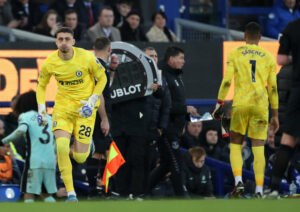Editorial (June 11, 2018) — It’s simply impossible to discuss Australia’s exploits on the international stage without prominently mentioning Tim Cahill.
Over the past decade and a half, the talented forward has essentially become the face of his nation on the soccer pitch. During that span, the Socceroos qualified for the World Cup in all four cycles. They also captured the AFC Asian Cup for the first time in 2015.
Australia comes to Russia at the tail end of an unprecedented era of success for the national team. And Cahill is arguably its ultimate purveyor. His 50 international goals are more than any other player in Australian soccer history. Should he play in all three of the Socceroos group games, he’ll tie Mark Schwarzer as the most capped Aussie player of all-time.
Tim Cahill: Australia’s Goal-Scoring Hero Ready for One Last Hurrah
Cahill’s Arrival in 2006
Throughout his international career, Cahill’s ability to find the net in big games has been on display time and time again. Half of his international goals came in either World Cup qualifying or in the tournament itself. It included announcing his arrival on the global stage in rather emphatic fashion during the 2006 World Cup in Germany.
Drawn into Group F with Brazil, Croatia, and Japan, the Socceroos opened in Kaiserslautern against the Japanese. A Shunsuke Nakamura goal gave the Samurai Blue a 1-0 lead they’d take into halftime. Things looked bleak for Australia a half hour after Cahill came on in the 53rd minute. That’s when he morphed into a super sub.
His poacher’s goal in the 84th minute made Cahill the first ever Australian to score in a World Cup. The team made the 1974 tournament but were held scoreless. He completed a brace five minutes later with John Aloisi adding another in stoppage time to give their side an exhilarating comeback win.
After falling to Brazil and tying Croatia in their subsequent matches, Australia found themselves second in the group. As a result, they advanced to the round of 16 and gave Italy all they could handle. The match was scoreless until Francesco Totti converted a penalty in the fifth minute of second-half stoppage time to keep the Azzurri alive in a tournament they eventually won.
A Bright Spot Despite Ignominious Endings in 2010, 2014
Though the next two World Cups ended in disappointment given Australia didn’t make it out of the group stage in either of them, Cahill found the net in both. One of the distinguishing characteristics of his game is that he boasts an aerial ability that belies his 5’11” frame. That was on full display in the group finale during the 2010 competition.
In a game Australia needed to win to have any chance of making the second round, Cahill stepped up. His 69th-minute header opened the scoring against Serbia in a game they eventually won, 2-1. It had them tied with Ghana on points. But a 4-0 defeat to Germany in their first group game condemned the Aussies to an early exit via goal difference.
Four years later, the Socceroos dropped all three games in a challenging group that included Chile and both 2010 finalists, the Netherlands and Spain. Cahill opened the tournament with another impressive goal off his head in a 3-1 defeat to the Chileans. Then came one of the goals of the tournament against the Dutch. Just one minute after Arjen Robben made it 1-0 Holland, Cahill fired a rocket of a full volley past Jasper Cillessen.

Though his team eventually fell by a 3-2 scoreline, Cahill left an indelible impact not just on the game, but on the tournament as a whole with one of the most jaw-dropping goals in World Cup history.
Scoring in the Big Moments
The hallmark of an elite goal-scorer is coming through in the clutch. It’s one thing to bag a multitude of goals in meaningless friendlies. But can you do it in the moments that matter? Cahill’s quality in that regard is unquestioned considering that 37 of his 50 international goals have come in major tournaments and World Cup Qualifying.
Since Australia moved from Oceania to Asia, Cahill has scored in all three Asian Cups his national team has competed in. Most recently, he led the Socceroos in goals during their loan triumph at the regional tournament in 2015. His standout performance came in the quarterfinals against China when he registered a second-half brace.
Two years later, even in the twilight of his career, he delivered when his team needed it most. After finishing third in Group B of AFC World Cup Qualifying round three, they faced the third-place team from Group A, Syria, in a two-leg playoff. The winner would face CONCACAF’S fourth-place team for a spot in the World Cup.
Syria’s advancement was a great story given the horrific civil war engulfing the country. And they gave the favored Aussies a determined fight over both legs. After Syria’s home game (played in Malaysia due to the conflict) finished 1-1, the two traveled to Sydney for the second leg.
Omar El Somah put the Syrians up 1-0 in the sixth minute. But Cahill equalized seven minutes later and the score stayed that way after 90 minutes. Four minutes into the second extra time session, it was Cahill again. Both tallies came off his head, the latter booking the Aussies date with Honduras whom they dispatched to confirm their spot in Russia.
The Coming End of the Road
Cahill comes to Russia with his soccer career clearly on its last legs. Not only is he the fourth oldest player at this edition of the World Cup. He’s one of just four who were born in the 1970s. In addition to that, he’s the only player in the entire tournament without a club after Millwall released him at the conclusion of their recent season. When Australia’s time at this tournament concludes, it will likely signal that the career of its most iconic soccer player is at an end.
But until then, the task at hand awaits for Cahill and his Socceroo teammates. On paper, it seems an uphill battle at best. Getting out of a Group C that includes France, Denmark and Peru is no easy feat. And most observers don’t give the Aussies much of a chance. But they’re coming into the tournament with some momentum after wins against the Czech Republic and Hungary in their final two friendlies ahead of this coming Saturday’s opener against France.
Cahill’s role on the team this time around is not just an on-field contributor. He’s also a mentor to the younger players in the squad, including Daniel Arzani. Ironically enough in relation to Cahill, the 19-year-old winger is the youngest player at the 2018 World Cup. The two were once teammates at Melbourne City in Australia’s A-League with Arzani counting Cahill as a trusted confidant and friend.
The phrase “father time is undefeated” has become a tired sports cliché in recent years. But a cliché reaches such a status because there’s a certain truth to its words. This is Cahill’s final World Cup. That much is certain. What’s also certain is that Cahill’s status as the most prolific goal-scoring talisman in Australian soccer history is unquestioned. Whether or not he has just a little bit more ammo left in his arsenal to help his nation surprise to the upside will become manifest in a fortnight’s time.






